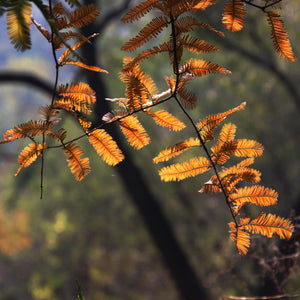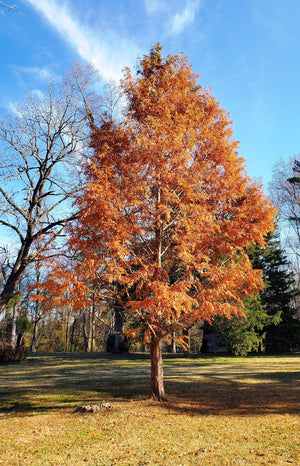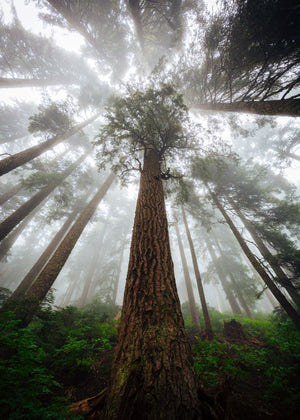The Redwood Guide
Redwood trees are a botanical marvel that graces our natural landscapes with a majestic and timeless presence. Their towering stature, cinnamon-hued bark, and lush foliage exude an aura of grandeur, captivating all who encounter them in gardens and outdoor spaces. These magnificent giants are renowned for their resilience and have the power to thrive in diverse environmental conditions when nurtured with care and attention. Whether you're yearning for a serene forested sanctuary or envisioning a show-stopping centerpiece in your garden, redwood trees stand as an exceptional choice. These arboreal wonders have the ability to elevate your landscape, infusing it with an ageless beauty that resonates for generations.

About
Redwoods, encompassing the Sequoia and Metasequoia genera, stand as nature's towering giants and are celebrated for their awe-inspiring presence and ecological significance. These remarkable trees are native to the Pacific coast of North America and eastern Asia, thriving in temperate regions that include the western United States, particularly California, and parts of China. Redwoods, both the Coast Redwood (Sequoia sempervirens) and the Dawn Redwood (Metasequoia glyptostroboides), showcase a distinctive blend of characteristics that highlight their profound role in local ecosystems.
An outstanding feature of redwoods is their massive, reddish-brown trunks that can soar to incredible heights. These colossal trees reach for the skies and create a stunning contrast against the lush, verdant foliage that adorns their towering frames. With their evergreen, needle-like leaves, redwoods are icons of endurance in nature.
Beyond their visual magnificence, redwoods hold a profound ecological role. These trees provide habitat and sustenance for a rich tapestry of wildlife. From the smallest forest creatures to larger mammals and birds, redwoods offer a sanctuary. They also contribute to soil stability and water retention, enhancing the health of their surrounding ecosystems.
Redwoods' adaptability to different soil conditions and their capacity to withstand various climatic challenges, from foggy coastlines to wetlands and even urban environments, make them a versatile choice for landscaping and ecological restoration projects. Both the Coast and Dawn Redwoods are celebrated for their unique attributes, with the Coast Redwood being the tallest tree on Earth and the Dawn Redwood representing a living fossil.
Whether you plant redwoods as an awe-inspiring centerpiece in a garden, to create a resilient windbreak, or as part of an intricate landscape design, their enduring elegance is sure to enrich any environment. These majestic trees stand as symbols of nature's grandeur, and by nurturing and preserving them, you play a vital role in safeguarding their legacy and supporting the ecosystems they sustain.

Planting
Redwoods, whether the towering Coast Redwood or the graceful Dawn Redwood, demand specific care and considerations to ensure their successful establishment and growth. Here are some general guidelines for planting and caring for redwoods:
Soil: Redwoods flourish in well-draining, loamy soils that are rich in organic matter. These trees prefer soils with a slightly acidic to neutral pH. Before planting, prepare the site by ensuring the soil is loose and well-aerated. Incorporate ample organic matter like compost to enhance both drainage and fertility. This is especially important given redwoods' love for moisture-retentive soil.
Sunlight: Redwoods, particularly Coast Redwoods, thrive in full sun. Ensure your planting location receives a minimum of six hours of direct sunlight daily. While they prefer full sun, they can tolerate some shade, especially in regions with intense heat and dry spells.
Watering: Proper watering is crucial for the initial establishment of redwoods. Provide the tree with deep and thorough watering immediately after planting to settle the roots. Throughout the first year, continue to provide consistent irrigation. Water deeply once or twice a week, adjusting the frequency based on local rainfall and soil moisture levels. Avoid overwatering, as it can lead to root rot. The ability to retain soil moisture is essential for redwoods' health.
Mulching: Apply a layer of organic mulch around the base of your redwood tree to preserve moisture, suppress weed growth, and regulate soil temperature. Suitable mulch materials include wood chips, bark, or compost. Ensure that the mulch is kept a few inches away from the trunk to prevent excess moisture buildup, as redwoods can be sensitive to excessive moisture around the base.
Pruning: Redwoods generally require minimal pruning, especially in the early stages. Focus on removing any dead, damaged, or crossing branches to maintain a strong and balanced framework. Pruning should be carried out during late winter or early spring while the tree is dormant, ideally before new growth begins. This helps maintain the tree's natural shape and promotes its overall health.
By following these fundamental planting and care guidelines, you can ensure the successful establishment and healthy growth of your redwoods. These majestic trees will reward your efforts by enhancing the beauty and ecological significance of your landscape for generations to come.

Care
Redwoods, whether they're the towering Coast Redwoods or the elegant Dawn Redwoods, require specific care to ensure their optimal growth and long-term health. Here are some general guidelines for the care of redwood trees:
Watering: Redwoods appreciate consistent watering, especially during the growing season. Aim to provide about one inch of water per week, adjusting this based on local rainfall. It's crucial to water deeply and thoroughly to encourage deep root growth. Avoid shallow watering, as it can lead to stress and dehydration in the tree. In periods of drought or during high-temperature conditions, you may need to increase your watering frequency to maintain adequate soil moisture.
Pruning: Redwoods typically do not require extensive pruning. However, it's advisable to remove any dead, damaged, or crossing branches to maintain the tree's overall health and appearance. You may also perform shaping to achieve the desired size and form. Pruning is best done during late winter or early spring before new growth begins. Ensure that you use clean, sharp pruning tools to minimize the risk of damaging the tree. Deadheading spent flowers can also stimulate new growth and potentially lead to a second round of blooming.
Fertilizing: Fertilizing can promote healthy growth and vigor in redwood trees. Apply a balanced, slow-release fertilizer in the spring or early summer, following the recommended application rates and timing provided by the manufacturer. It's essential to avoid over-fertilizing, as excessive nutrients can harm the tree's roots. When in doubt, it's safer to use less fertilizer rather than excess.
Soil and Sunlight: Redwoods thrive in well-drained soil that's consistently moist. These trees prefer full sun exposure, although they can tolerate some partial shade. While redwoods are adaptable to different soil types, ensuring well-draining soil is essential for their optimal growth. Additionally, applying mulch around the base of the tree can help retain moisture and regulate soil temperature.
Pests and Diseases: Redwoods are generally resistant to many pests and diseases. However, it's still essential to keep an eye out for common issues such as aphids and spider mites. If you notice any signs of infestation or disease, take prompt action and treat the tree with appropriate insecticides or fungicides to prevent the problem from spreading.
By following these fundamental care guidelines, your redwoods will flourish, providing not only natural beauty but also contributing to the health of your local ecosystem. These magnificent trees can thrive for generations when given the proper care and attention.

How To Use
Redwood trees are incredibly versatile and can be used in various ways to enhance your landscape. Here are some recommendations based on their unique characteristics:
Majestic Focal Point: Redwood trees possess a commanding presence, making them a perfect choice as a focal point in your landscape design. Plant a single redwood tree in an open area to showcase its towering form and iconic red-hued bark. Alternatively, create a captivating visual impact by planting a group of redwoods together, creating a mini forest within your landscape.
Natural Canopy for Shade: With their expansive canopies, redwoods provide excellent shade. Strategically plant them near outdoor seating areas, patios, or decks to create cool and comfortable spaces where you can relax and enjoy the outdoors, even on the hottest days.
Effective Windbreak: Redwoods, known for their dense foliage and robust growth, can serve as a highly effective windbreak. Plant them in a row to shield your garden or home from strong winds, providing a natural barrier that not only protects your landscape but also adds to its aesthetic appeal.
Privacy Screen: Take advantage of the dense foliage of redwood trees to create a natural privacy screen in your landscape. Plant them in a row along your property line to establish an attractive and functional barrier that enhances both privacy and the overall aesthetics of your outdoor space.
Wildlife Haven: Redwoods contribute to the biodiversity of your garden by attracting various wildlife species. Birds and other animals are drawn to these trees for shelter and for the seeds they produce. By planting redwoods, you can create a welcoming habitat for wildlife, allowing you to enjoy the sights and sounds of nature right in your own backyard.
When incorporating redwoods into your landscape, consider their growth rate and environmental requirements. Ensure they are planted in areas that receive adequate sunlight and provide well-drained soil. Redwoods, with their towering majesty and unique characteristics, are an extraordinary addition that will elevate the beauty and functionality of your outdoor environment.
Conclusion
Redwood trees stand as both captivating and versatile additions to any landscape. Their awe-inspiring presence, distinctive characteristics, and ecological importance have solidified them as a coveted choice for a wide array of outdoor settings. By adhering to proper planting and care practices, you can revel in the beauty and benefits that redwood trees bring to your environment. Whether you seek to create a picturesque driveway, carve out a tranquil retreat in your backyard, or make them a focal point in your landscape design, redwood trees offer a world of possibilities for enhancing the allure of your outdoor space. Their towering majesty, iconic appearance, and rich ecological contributions set them apart as an extraordinary choice for your landscape. With dedication and mindful care, you have the power to craft a breathtaking landscape, one that not only enriches your immediate surroundings but also leaves a lasting legacy of natural beauty and enjoyment for years to come.

